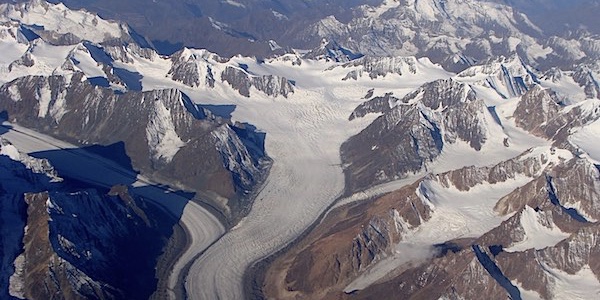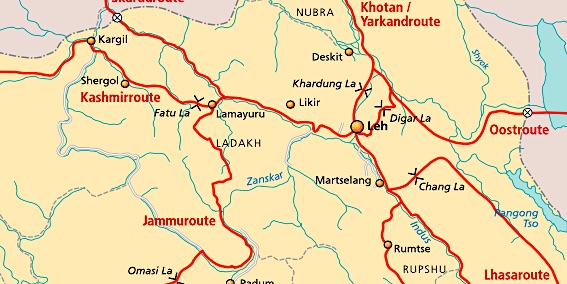LADAKH - SHAM TREK
Tour - 10 days/ 4 days trekking
SHAM TREK
Tour - 10 days/ 4 days trekking
About LADAKH
Ladakh is a part of the Indian Himalayas It is located between the Kunlun mountain range in the north and the main Himalayas to the south. Although part of India now, and earlier of the princely state of Kashmir, Ladakh has been an independent kingdom for almost 900 years.
Ladakh is well-known for its starkly beautiful mountain scenery. As a result of its location in the rain shadow of the main Himalayan Range its climate is extremely dry, and due to the high altitude – most valleys are situated at 3300m or higher – winters can be extremely cold. Summers, however, are generally pleasant if not warm and sunny. Ladakh is inhabited by a mix of Indo-Aryan and Tibetan people. Especially the latter, with their colourful buddhist culture, have given the region the nickname of ‘Little Tibet.’
Ladakh in the narrower sense is the Indus Valley with adjacent areas. It is bordered by two mountain ranges: in the northeast by the Ladakh Range, in the southwest by the Zanskar Range. The area around the capital Leh, and further upstream towards Tibet, is referred to as Upper Ladakh. Lower Ladakh is the area further downstream to Kargil, where the Indus enters Pakistan.
The remoter areas of Zanskar, Nubra and Rupshu are now seen as regions of Ladakh. In the past, these areas were sometimes part of Ladakh, sometimes not. They can be visited from Leh by car or on foot. The latter would be your means of transport, if you are up to it. Because, while jeep trips in Ladakh are very rewarding indeed, trekking will give you an even in-depth experience of the land and the people, with the added bonus of a total renovation of body and soul.
Ladakh can be reached by air or overland. On this tour you fly in and out. In case you have enough time available, we strongly recommend to take the overland route, in which you travel by train and car to Ladakh through Manali, in the Himalayan state of Himachal Pradesh. This is one of the greatest car journeys in the world.
Region
Ladakh
(India)
Best Time
May end - mid October
No. Of Days
10 days,
4 days trek
Trip Character
Trekking tour
Sleeping Altitude
3200 - 3500 m.
Trip Character
Home stay trek
Level: 1
Price
INR XXX/ $ XXX
ABOUT THIS TOUR
It is a misunderstanding that trekking in Ladakh is only for the hardy, and that it involves climbing passes of 5000-plus meters high while sleeping on rocky ground in the cramped space of a trekkers tent.
If there’s a trip that proves that, it’s this one. The tour through Sham lets you get acquainted with Ladakhi culture and landscape in a relaxed manner. And almost nowhere else will you find such incredible contrasts between barren, colourful mountains and deep green oases with murmuring irrigation channels and flowering rose bushes.
The starting point, Likir, is only 60 km from Leh on the road to Kargil. From here, the tour leads along the slopes of the Ladakh Range to the northwest, parallel to the Indus Valley. The end point, Temisgang, is again on the paved road.
The route remains everywhere below 4000 m and the daily walking time below five hours. If you leave early can arrive around noon, so the afternoon is available for reading a book with your feet in the stream or for exploring the village at leisure. Thanks to guesthouses on all overnight locations, there is no need to bring a tent.
Before setting out on the trek you’ll spend three nights in Leh to get used to the altitude and to explore the Indus Valley and its many beautiful monasteries near Leh. At the end of the trek you will be taken to Lamayuru Gompa, a picturesque old monastery perched on a mountain slope overseeing a surreal ‘moonscape’, as well as Ladakh’s oldest monastery , Alchi Gompa, before returning to Leh.YOUR custom-made TRIP
The tour described here, as well as the other ones on our website, are mainly meant as suggestions. We would be happy to offer you a travel proposal that fully meets your personal demands and expectations. That means that you choose where you want to go, what level of accommodation and type of transport you want and what activities you prefer.
Please let yourself be inspired by this and other trips on our website and then drop us a line (or call us up) to explain your travel wishes. We will be happy to help you put together the perfect trip. You can reach us over e-mail, Messenger, Whatsapp or mobile phone.
EXTENSIONS & VARIATIONS
Apart from the tour as described here, you could consider the following add-ons and changes:
- After returning to Leh – or before the trek – do a 6-day exploration jeep tour to Nubra Valley, Shyok and Pangong Tso. See here.
- Do a more challenging trek instead of the Sham trek. For instance, the Chilling – Lamayuru trek. On this 4- or 5-day trek you sleep in trekkers tents while a walk-along cook prepares your meals. You walk longer distances, climb higher passes but the rewards are even better views, more authentic villages. See here.
- Spend a day rafting on the Indus. There are different grades available, so there is the easy but fun to do level as well. Professional oarsmen will be with you in any case. You will be picked up from your hotel and dropped off there again at the end of the day, a pic-nic lunch is included.
ITINERARY
-
Day 1: Flight Delhi - Leh
The flight from Delhi to Leh takes only 1 hour but on a clear day, is breathtaking. Stepping down from the aircraft you may feel the altitude, but even if you don’t, it is very wise to take the rest of the day off. Stay at the hotel or at best walk around Leh bazar. Altitude: 3500m. -
Day 2 & 3: In Leh
If you wake up today without a headache you may consider yourself fit to go on not too strenuous walks/excursions in and around Leh. Else it is better to stay at the hotel another day. Altitude: 3500m. -
Day 4: Leh - Likir; Trekking to Yangthang (2 h drive, 4 h walking)
After a transfer to Likir, and a look at the picturesque Likir Gompa, perched on a hillock, you'll start you 4-day trek. Today you cross a low pass to picturesque Yangthang. Altitude 3500 → 3600 → 3720 → 3630m. -
Day 5: Trekking Yangthang - Ridzong - Yangthang (4 h walking)
You walk up and down through a beautiful gorge to the hidden monastery of Ridzong. Part of the 'reformed' Gelugpa (Yellow Hat) Sect the monks here adhere to a very austere lifestyle. Altitude 3630 → 3400 → 3630m. -
Day 6: Trekking Yangthang - Hemis Shukpachan (3 - 4 h)
Today is a short walk. You'll pass the 3750m high Sermanchan La (3750m) to the beautiful village of Hemis Shukpachan. Altitude 3630 → 3875 → 3575m. -
Day 7: Trekking Hemis Shukpachan - Temisgang (4 - 5 h) & car to Lamayuru (2 h)
Crossing another pass, the colorful Meptek La (3750m) takes you to Ang, again a charming village with many apricot orchards. Continuing over a jeep track you'll reach Temisgang. The car will be waiting here to take you to Lamayuru Gompa, where you'll stay near the monastery. Altitude 3575 → 3825 → 3260 → 3500m. -
Day 8: Lamayuru - Alchi - Leh (4 -5 h)
Today you return to Leh. You'll follow the old caravan route from Kashmir to Ladakh, which descends from a small pass above Lamayuru Gompa in a series of spectacular hairpin bends. Further down the Indus you'll visit Alchi Gompa, Ladakh's oldest temple, before continuing to Leh. Altitude 3500 → 3000 → 3500m. -
Day 9: In Leh
Day to spend as you like. In case you want to do any excursions the management of the hotel will be most happy to assist. See day 3 & 4 for suggestions. Altitude 3500m. -
Day 10: Flight Leh - Delhi
After breakfast, a taxi will take you to the airport for your flight back to Delhi.
HIGHLIGHTS OF THIS TOUR
Flight to Leh


LEH
CARAVAN ROADS OF LADAKH


SHAM TREK
LOWER INDUS VALLEY (WEST)





